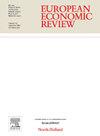在职求职和生产率-工资差距
IF 2.4
2区 经济学
Q1 ECONOMICS
引用次数: 0
摘要
我们研究了工人和公司在职搜索如何对生产率工资差距产生不同的影响。虽然工人和企业在职求职的增加都提高了生产率,但它们对工资却产生了相反的影响。在职员工的增加增加了员工的外部选择,使他们能够要求更高的工资。企业在职搜索的增加提高了企业相对于员工的议价地位,因为它增加了工作的不安全感,增加了招聘率和会议率之间的差距,使企业能够将更小比例的生产率转化为工资,从而扩大了生产率与工资的差距。从数量上看,该模型解释了1990年至2017年间观察到的美国生产率-工资差距差异的四分之一左右。本文章由计算机程序翻译,如有差异,请以英文原文为准。
On-the-job search and the productivity-wage gap
We examine how worker and firm on-the-job search have differential impacts on the productivity-wage gap. While an increase in both worker and firm on-the-job search raise productivity, they have opposing effects on wages. Increased worker on-the-job search raises workers’ outside options, allowing them to demand higher wages. Increased firm on-the-job search improves firms’ bargaining position relative to workers’ by raising job insecurity and the wedge between hiring and meeting rates, allowing firms to pass-through a smaller share of productivity to wages and enlarging the productivity-wage gap. Quantitatively, the model accounts for about a quarter of the observed divergence in the US productivity-wage gap between 1990 and 2017.
求助全文
通过发布文献求助,成功后即可免费获取论文全文。
去求助
来源期刊

European Economic Review
ECONOMICS-
CiteScore
4.70
自引率
3.60%
发文量
170
期刊介绍:
The European Economic Review (EER) started publishing in 1969 as the first research journal specifically aiming to contribute to the development and application of economics as a science in Europe. As a broad-based professional and international journal, the EER welcomes submissions of applied and theoretical research papers in all fields of economics. The aim of the EER is to contribute to the development of the science of economics and its applications, as well as to improve communication between academic researchers, teachers and policy makers across the European continent and beyond.
 求助内容:
求助内容: 应助结果提醒方式:
应助结果提醒方式:


